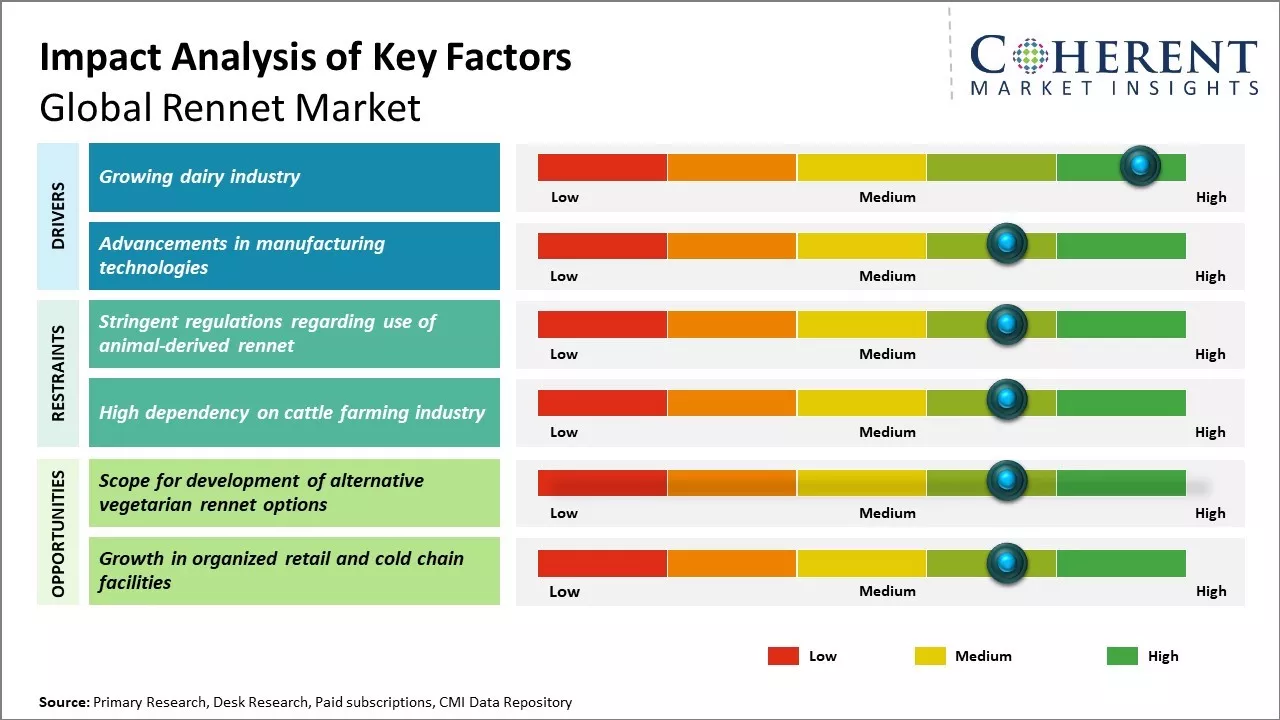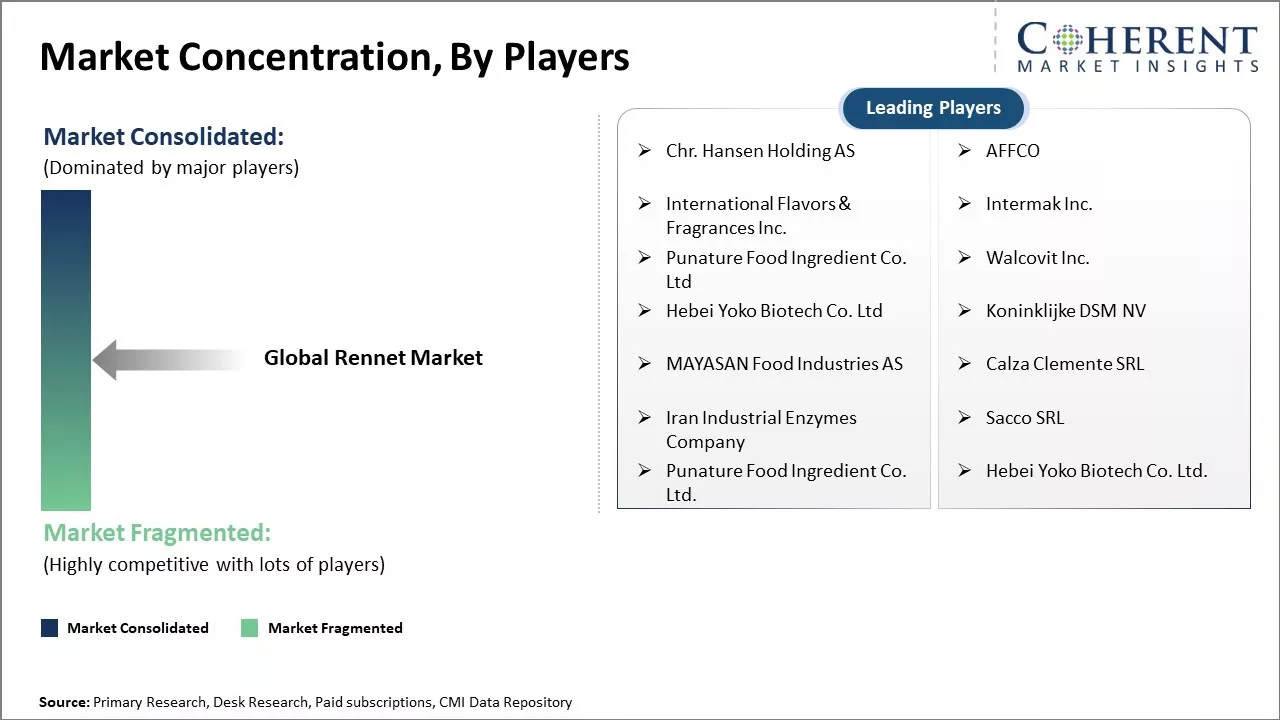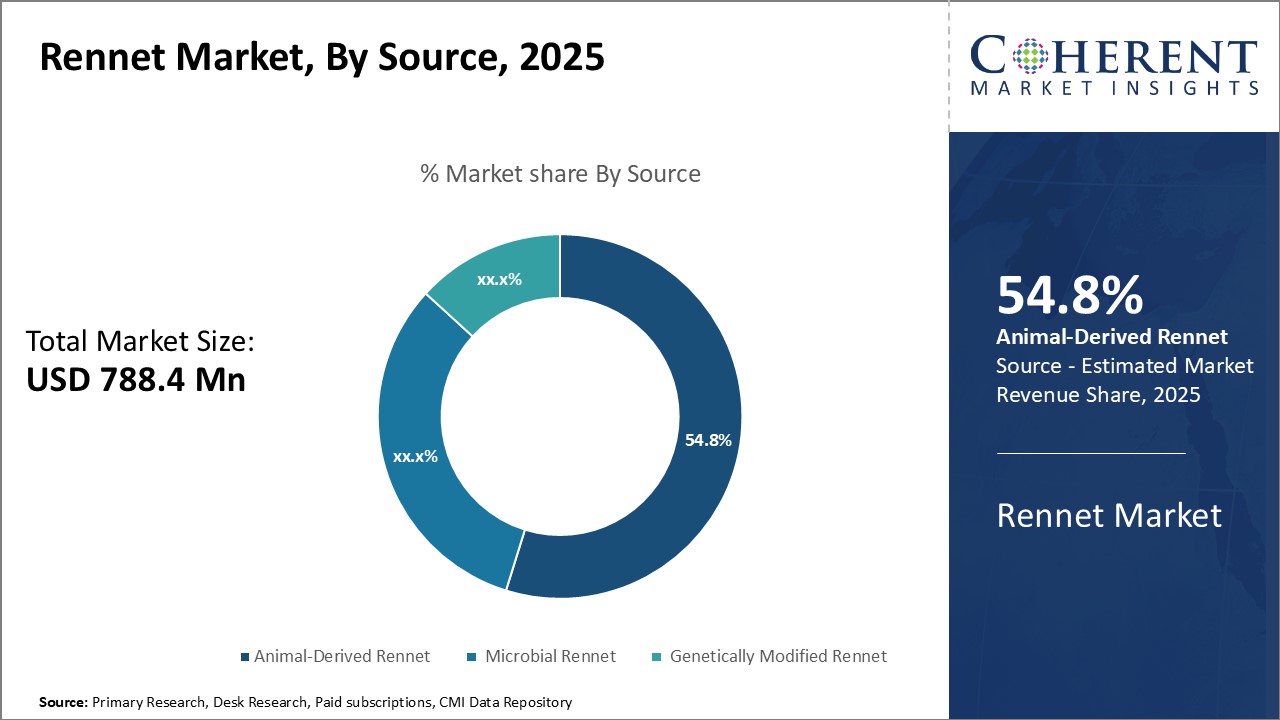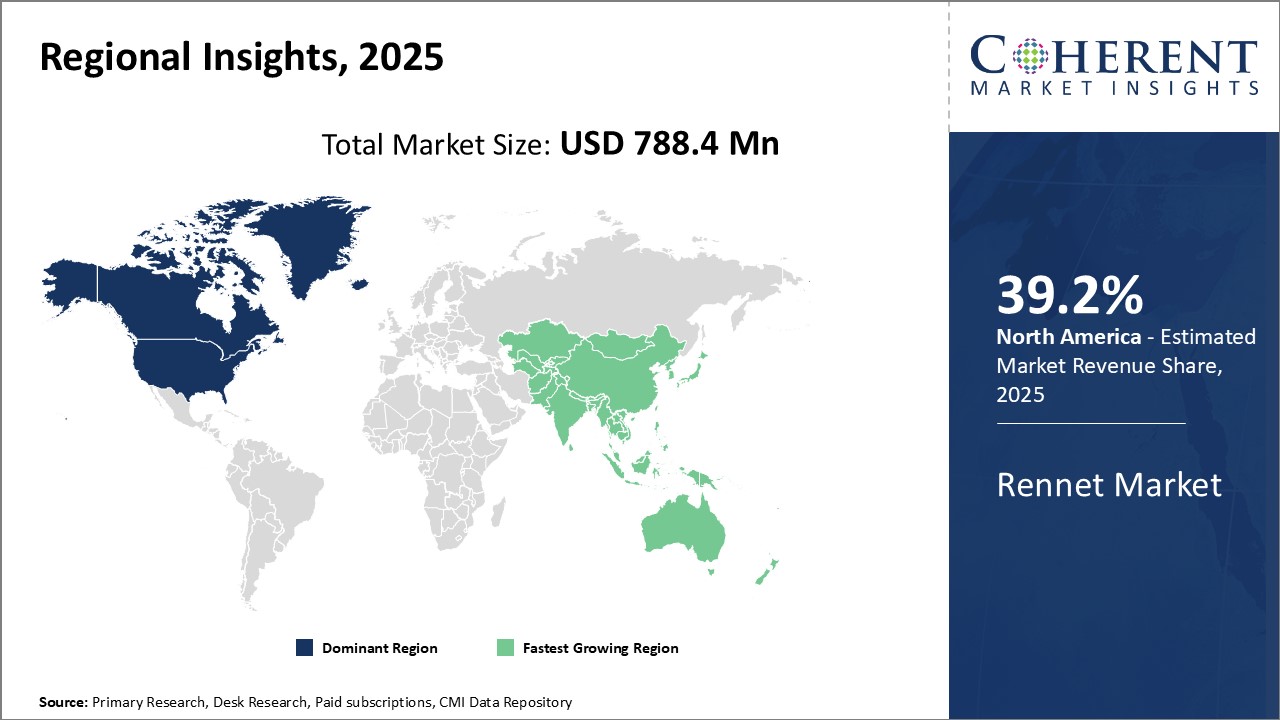The rennet market is estimated to be valued at USD 788.4 Mn in 2025 and is expected to reach USD 1,155.2 Mn by 2032, exhibiting a compound annual growth rate (CAGR) of 5.6% from 2025 to 2032.

Discover market dynamics shaping the industry: Download Free Sample
The growing demand for cheese and other dairy products is driving the need for rennet across major economies. Additionally, the rising fast food and quick service restaurant industries has increased the demand for processed cheese, which, in turn, is supporting the rennet market growth. Furthermore, advancing technologies used in rennet production are helping lower production costs. New product launches catering to vegan and kosher consumers through the use of non-animal derived rennet alternatives are also boosting market revenues. However, stringent regulatory environment over the use of animal-derived rennet may hamper the market growth to some extent over the coming years.
Drivers of the Market:
Growing dairy industry
The global dairy industry has seen significant growth over the past few decades. Increased milk consumption as a result of rising incomes and urbanization in developing countries has boosted dairy production. Countries like India, China, and many Southeast Asian nations have emerged as major dairy consumers. As per estimates, India is the largest milk producer in the world while China is the biggest importer of dairy products. Rising affordability has led to dairy becoming a vital part of the diet for hundreds of millions of people globally.
This rapid growth in the dairy sector has led to increased demand for rennet. Rennet is a crucial ingredient required for converting milk into solid curd which forms the basis of cheese production. Specialized dairy enzymes present in rennet help in coagulation of milk during cheese making. As international cheese consumption rises in tandem with rising living standards, cheese manufacturers are under pressure to ramp up production capacity. This has resulted in higher demand for rennet from cheese makers worldwide. Leading rennet producers are investing in expanding capacities to capitalize on opportunities presented by a booming global cheese market. Emerging economies with huge dairy potential will be key drivers of rennet demand going forward as their cheese industries establish themselves globally.

Get actionable strategies to beat competition: Download Free Sample
Advancements in manufacturing technologies
The rennet manufacturing industry is innovating continuously to improve production processes and efficiencies. Adoption of advanced technologies allows rennet producers to better meet the dynamic needs of industrial customers. State-of-the-art fermentation, drying, and packaging equipment enable large scale, cost-effective rennet synthesis while maintaining high product quality standards. Automation is reducing dependency on manual labor and allowing custom formulations tailored for specific cheese varieties.
Research is also ongoing to develop novel rennet formulations with enhanced milk coagulating properties. Genetic engineering techniques are being applied to modify rennet producing microbial strains for improved yield and stability. These innovations are empowering cheese makers to experiment with newer recipes and widen their portfolio. They also help rennet manufacturers expand into international markets by complying with varied regulatory norms. Much focus is on more sustainable production methods with reduced environmental footprint. Investments into cutting-edge R&D facilities signal the industry's long term commitment to technological leadership. Advanced rennet types resulting from continuous innovations should sustain market demand in the years ahead.
Key Takeaways from Analyst:
The global rennet market continues to grow steadily driven by the increasing demand for cheeses across regions. The growing popularity of specialty and artisanal cheeses especially in Europe and North America is a key growth driver for the market. Asia Pacific is expected to be the fastest growing region for the rennet demand over the next 5 years supported by rising cheese consumption in countries like India, China, and Southeast Asia.
Factors like pricing pressures due to the presence of substitutes and availability of alternatives for cheese production are expected to restrain the market growth to some extent over the forecast period. The emergence of microbial rennet as a potential substitute for traditional rennet could challenge the demand. Meeting stringent purity and safety regulations for food-grade rennet products also remains a challenge.
The rising popularity of vegetarian and non-animal rennet varieties offers opportunities for key players. The growing cheese production in Latin America fueled by demand from Brazil and Argentina also provides new opportunities. Innovation and development of new application specific rennet formulas suitable for various cheese varieties could boost market growth.
Market Challenges: Stringent regulations regarding use of animal-derived rennet
Stringent regulations regarding the use of animal-derived rennet are indeed restraining the growth of the rennet market. Many countries and federal bodies have implemented strict guidelines in the recent past to curb the use of animal rennet owing to animal welfare concerns. For example, the European Union passed a directive in 2008 that banned the use of animal rennet in cheese production and promoted the shift to microbial or plant-based rennet. This was a major setback for the traditional cheese makers in Europe who relied on animal rennet. Several cheese varieties that require animal rennet could not be produced as per the original recipes anymore. The adoption of alternatives also impacted the taste and texture of some popular cheese varieties.
Market Opportunities: Scope for development of alternative vegetarian rennet options
The demand for vegetarian and plant-based food options has been steadily rising in recent years. More consumers are looking to reduce their meat consumption or eliminate it altogether for health, ethical, or environmental reasons. As the market for vegetarian cheeses and other non-meat foods expands to meet this demand, alternative rennet options not derived from animal sources could see significant growth opportunities.

Discover high revenue pocket segments and roadmap to it: Download Free Sample
Insights by source: Traditional preferences
In terms of source, animal-derived rennet is expected to contribute 54.8% share of the market in 2025. Animal-derived rennet has been used for centuries in cheese production and remains the preferred choice for many cheesemakers and consumers. Derived from the stomach lining of young ruminants, such as calves or lambs, animal rennet catalyzes the coagulation of casein in milk more effectively than other sources. This reliable and time-tested functionality has helped animal rennet gain and retain widespread acceptance across global cheesemaking.
Moreover, the complex peptides and enzymes present in animal rennet impart desirable flavor and texture attributes to aged cheeses. Traditional and artisanal cheese varieties in particular rely on animal rennet to develop their distinctive characteristics over months of aging. Maintaining the heritage qualities that have defined such cheeses for generations remains a key factor sustaining demand.
While concerns over religious restrictions and animal welfare have boosted interest in alternative rennet, many consumers still prefer cheeses produced using animal rennet. This is due both to tradition and a perception that such cheeses have a purer, more refined taste. Established brands have been reluctant to switch to non-animal sources and risk alienating their traditional customer base. As a result, artisanal producers especially have largely resisted change, keeping animal rennet as the mainstay of small-scale cheese production.
Insights by application: Cheese production dominates the rennet market owing to widespread usage
In terms of application, cheese production is expected to contribute 43.8% share of the market in 2025. Given that rennet is chiefly utilized to coagulate milk into curds for cheese production, it is unsurprising that cheese making accounts for the bulk of rennet demand globally. Virtually every type of cheese relies on rennet to transform liquid milk into its semi-solid curd form, whether through traditional or industrial cheesemaking methods.
Hard cheeses variety especially consume sizable volumes of rennet, as their longer aging processes require more ample curd development aided by rennet. Even processed cheese, which comprises a major global market, depends on rennet to first produce the natural cheese components that are then blended together. Outside of cheese, rennet finds only niche applications. It has limited usage in certain non-dairy products like desserts but does not approach the scale of cheese production. With worldwide cheese consumption continuing to increase in both developed Western countries as well as emerging markets, cheese makers correspondingly drive greater rennet procurement. As new artisanal varieties are created and globalization introduces diverse regional cheese styles to more consumers, the cheese industry—and rennet demand along with it—will likely persist on an upward trajectory. No other downstream usage comes close to matching cheese production’s ubiquity or annual volume needs of rennet. This factor above all others cements cheese making as the single largest influencer of trends within the rennet market.

Need a Different Region or Segment? Download Free Sample
The North America region currently dominates the global rennet market. The region is expected to account for 39.2% of the market share in 2025. The U.S. is the leading producer and consumer of rennet globally. This can be attributed to the strong dairy industry presence in the region for decades. Rennet finds widespread application in cheese production which accounts for over 60.5% of its demand. With the U.S. being one of the top cheese consuming countries globally, it ensures a steady demand for rennet from the food processing sector. Moreover, several major rennet manufacturing companies, such as Chr. Hansen and DSM Nutritional Products, have established production facilities as well as R&D centers in the U.S., ensuring easy availability. This coupled with the lack of stringent import regulations has made North America the most preferable destination for international rennet suppliers.
The Asia Pacific region has emerged as the fastest growing regional market for rennet. Rapid urbanization, rising disposable incomes, and evolution of food consumption patterns are driving the growth of the dairy industry across developing nations like India and China. This has significantly boosted the rennet demand from these countries to meet their cheese manufacturing needs. Furthermore, growing health consciousness has increased the demand for enzyme modified and microbial rennet from the nutraceuticals and pharmaceutical sectors. India especially has witnessed a proliferation of small- and mid-sized domestic rennet players to cater to the food processing industry. While import dependence is still dominant, the ‘Make in India’ initiative will encourage local production and help Asia Pacific consolidate its position as a high potential market. Rennet manufacturers are also exploring opportunities to export productions to European and American cheese makers, taking advantage of low labor and manufacturing costs in the region. If these trends continue, Asia Pacific looks set to surpass other regions in terms of rennet consumption rate in the future.
Rennet Market Report Coverage
| Report Coverage | Details | ||
|---|---|---|---|
| Base Year: | 2024 | Market Size in 2025: | USD 788.4 Mn |
| Historical Data for: | 2020 To 2024 | Forecast Period: | 2025 To 2032 |
| Forecast Period 2025 to 2032 CAGR: | 5.6% | 2032 Value Projection: | USD 1,155.2 Mn |
| Geographies covered: |
|
||
| Segments covered: |
|
||
| Companies covered: |
Chr. Hansen Holding AS, AFFCO, International Flavors & Fragrances Inc., Intermak Inc., Punature Food Ingredient Co. Ltd, Walcovit Inc., Hebei Yoko Biotech Co. Ltd, Koninklijke DSM NV, MAYASAN Food Industries AS, Calza Clemente SRL, Iran Industrial Enzymes Company, Sacco SRL, Punature Food Ingredient Co. Ltd., and Hebei Yoko Biotech Co. Ltd. |
||
| Growth Drivers: |
|
||
| Restraints & Challenges: |
|
||
Uncover macros and micros vetted on 75+ parameters: Get instant access to report
*Definition: The rennet market includes rennet products that are used in the production of cheeses. Rennet is an enzyme that is added to milk to separate curd from whey. It comes from the stomach lining of calves and young goats. The rennet market caters to large dairy producers and cheese makers who require rennet to manufacture cheese on a commercial scale. The main product types in the rennet market are animal-derived rennet and microbial rennet. The rennet market provides a vital input for the multi-billion dollar cheese industry worldwide.
Share
Share
About Author
Yash Doshi is a Senior Management Consultant. He has 12+ years of experience in conducting research and handling consulting projects across verticals in APAC, EMEA, and the Americas.
He brings strong acumen in helping chemical companies navigate complex challenges and identify growth opportunities. He has deep expertise across the chemicals value chain, including commodity, specialty and fine chemicals, plastics and polymers, and petrochemicals. Yash is a sought-after speaker at industry conferences and contributes to various publications on topics related commodity, specialty and fine chemicals, plastics and polymers, and petrochemicals.
Missing comfort of reading report in your local language? Find your preferred language :
Transform your Strategy with Exclusive Trending Reports :
Frequently Asked Questions
Joining thousands of companies around the world committed to making the Excellent Business Solutions.
View All Our Clients